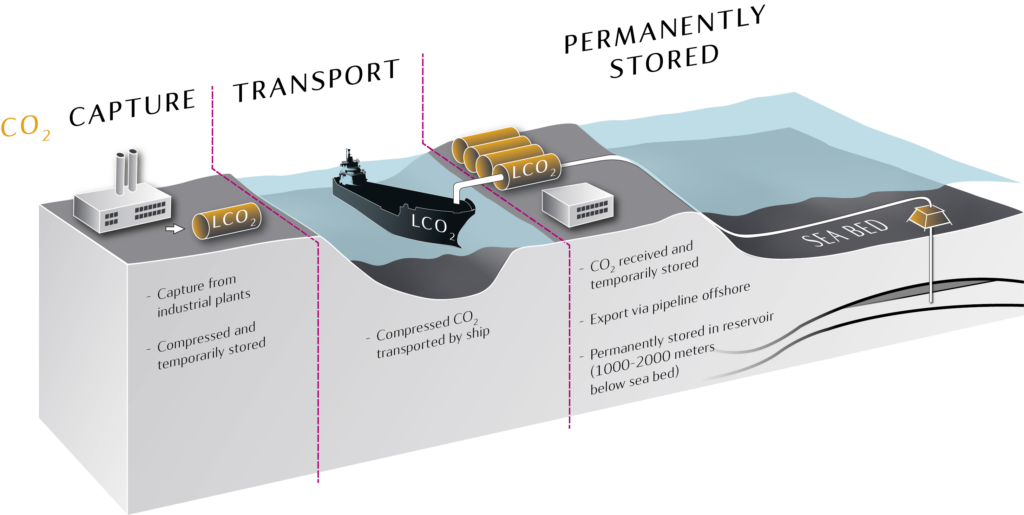Climate roadmap

The “Climate Roar” (klimabrøl) was 2019’s new Norwegian word of the year.[REMOVE]Fotnote: https://klimabrolet.no/en/ It described nationwide demonstrations on behalf of the climate and nature. A symptom of growing popular concern, these manifestations were intended to show support for politicians due to take decisions which would ensure that global warming could be kept to well below 2°C – in line with the Paris agreement.
With a long history in the petroleum age, Equinor was concerned at the same time to show the world at large that it appreciated the seriousness of the ongoing debate.[REMOVE]Fotnote: https://www.equinor.com/content/dam/statoil/image/how-and-why/climate/climate-roadmap-2018-digital.pdf Its annual report for 2020 stated:
Equinor acknowledges scientific consensus on climate change and supports the goals of the Paris Agreement. We recognise that the world’s energy systems must be transformed in a profound way to drive decarbonisation. At the same time universal access to affordable and clean energy must be ensured while supporting the United Nations sustainable development goals.[REMOVE]Fotnote: Annual report, 2020, Equinor.
Since the company’s operations on the Norwegian continental shelf (NCS) and internationally related largely to producing climate-unfriendly oil and gas, becoming more climate-neutral in the longer term was no simple task.[REMOVE]Fotnote: https://cdn.sanity.io/files/h61q9gi9/global/df1f0cb19f173c1e616f83263540fd98e366212f.pdf?sustainaiblity-report-2021-equinor.pdf. Solutions were nevertheless envisaged, related primarily to three issues – reducing emissions, carbon capture and storage (CCS) and liquid hydrogen.

Emission reductions
Common climate targets for 2030 and 2050 were announced in 2020 by Equinor together with Confederation of Norwegian Enterprise (NHO) and the Norwegian Confederation of Trade Unions (LO). Along with the other operator companies, the supplier industry and the shipping sector, Equinor was to reduce its greenhouse gas (GHG) emissions to near zero by 2050. Collectively, these players signalled that reaching this goal would cost roughly NOK 50 billion.[REMOVE]Fotnote: Equinor, LO og NHO sammen om nytt klimamål: Norsk sokkel skal bli utslippsfri – E24.
Although Equinor already considered itself a leader for producing oil and gas with low CO2 emissions, it set very ambitious targets for further measures. Emissions from fields operated by the company would be cut by 40 per cent in 2030 and 70 per cent from 2040, and reach near zero by 2050.
This meant specifically reducing CO2 released by both offshore facilities and land plants by five million tonnes in 2030, from about 13.9 million tonnes in 2018. Measures contemplated included enhancing energy efficiency and electrification using power from shore – as was already done on Troll and Johan Sverdrup – or offshore wind turbines.[REMOVE]Fotnote: https://www.aftenbladet.no/aenergi/i/K32AM6/equinor-satser-50-milliarder-kroner-paa-utslippsreduksjon-fram-mot-2030.

The precondition set by management for being able to meet these goals was stable operating parameters from government, including the tax regime. In order to electrify the installations it operated offshore, the company also depended on the necessary investment in and upgrading of the onshore power grid.
Both Frederic Hauge, head of Norway’s influential Bellona environmental organisation, and Labour leader Jonas Gahr Støre were positive to the climate targets when they were announced. In Hauge’s view, the offshore electrification plans demonstrated that the oil companies finally understood that they had to take action on the climate. Støre, for his part, noted that “although emissions from oil and gas derive first and foremost from the user [transport, industry and so forth] … production accounts for more than a quarter of Norwegian emissions … Making the NCS emission-free would represent a substantial contribution to reducing Norwegian emissions”.[REMOVE]Fotnote: Equinor, LO og NHO sammen om nytt klimamål: Norsk sokkel skal bli utslippsfri – E24.
Neither politicians nor the oil companies mentioned at the time that gas saved through electrifying offshore installations was sold on together with the rest of Norway’s gas output for burning in other countries. Cutting emissions on the NCS did not necessarily mean a reduction in the amounts released globally.[REMOVE]Fotnote: Ibid..
At the start of the 2020s, cross-political agreement existed in Norway on the need to reduce national GHG emissions, create greener workplaces and provide new opportunities for the supplier industry.
CCS
One measure Equinor wanted to continue pursuing was CCS. It had acquired experience with this since 1996 in offshore production, first on Sleipner, then on Snøhvit and elsewhere.
The Norwegian government and Statoil had failed to develop full-scale CCS in the “Moon landing” project – so called because it was meant to emulate the US drive to reach the lunar surface during the 1960s. Launched in 2007, this had terminated in 2013. Nevertheless, the Mongstad Technology Centre (TCM) continued its work with government grants as the world’s largest facility for testing and improving carbon capture.

Seven years later, in 2020, Equinor had several new CCS projects in a start-up phase. It was operator, for example, of the Northern Lights venture with Shell and Total.[REMOVE]Fotnote: https://norlights.com/news/northern-lights-summit-2022/. This aimed to develop plans for an infrastructure solution to transport CO2 from industrial facilities for intermediate storage at a terminal in Øygarden near Bergen. The gas would then be piped for permanent deposition in a formation 2 600 metres beneath the seabed south of Troll.[REMOVE]Fotnote: https://www.regjeringen.no/en/dokumenter/meld.-st.-33-20192020/id2765361/?ch=5 With financial backing from the Norwegian government and the EU, drilling of the first injection well in this project began on 5 August 2022.[REMOVE]Fotnote: https://norlights.com/news/drilling-co2-injection-wells/.
Northern Lights was part of Longship, the Norwegian government’s project for full-scale carbon capture, transport and storage in Norway.[REMOVE]Fotnote: Longship was unanimously approved by the Storting (parliament) – proposition no 33 (2020) – on 21 January 2021, and the plan for development and operation of Northern Lights was formally approved on 16 February 2021. This includes a large vessel to ship compressed CO2 from industrial facilities on the Oslo Fjord to the Øygarden terminal. Attention concentrated initially on carbon capture from cement production and waste incineration. The project was intended to demonstrate opportunities for decarbonising industrial operations in Norway, Europe and the rest of the world.[REMOVE]Fotnote: https://norlights.com/about-the-longship-project/.
In parallel with Northern Lights, Equinor is working to develop CCS capacity in the UK through a collaboration with five other energy companies. This Northern Endurance Partnership (NEP) plans to develop infrastructure for carbon transport and storage off the UK coast.[REMOVE]Fotnote: Annual report, 2020, Equinor.
Liquid hydrogen
A third priority area in a start-up phase was the production of liquid hydrogen. A highly flammable gas, hydrogen can be used in industrial operations or as a fuel in vehicles, where only water is emitted. That makes it a favourable option from a climate perspective.
Hydrogen can be produced in two ways – from water or natural gas. In the first case, where the end product is known as “green”, electricity is utilised and emissions are very limited if the power comes from renewable sources such as water and wind.
In the second case, “grey” hydrogen involves high CO2 emissions. But CCS can eliminate that drawback and provide a low-carbon alternative.
Denne filmen viser hvordan Equinor ser for seg at hydrogen kan hjelpe Storbritannia med å nå sitt utslippsmål. Foto: Equinor
Equinor and its partners – Air Liquide (operator) and power generator BKK (now Eviny) – began developing a project in 2020 for liquid hydrogen based on natural gas. The proposed plant was to be established at the Mongstad Industry Park near Bergen, where it could benefit from both the local refinery and expertise at the TCM.
The plan is to utilise the hydrogen particularly for fuelling ships, thereby helping to decarbonise the maritime sector (through the liquid to hydrogen (LH2) project). This accords with the climate goals set by the Norwegian government in collaboration with industry for decarbonising maritime operations.[REMOVE]Fotnote: Ibid.
Producing liquid hydrogen from natural gas in combination with CCS opens new commercial opportunities for Equinor, even though the market for this product is still small.
Energy transition plan 2022
Equinor is sticking in 2022 with the climate plan from two years earlier. The emission goals for 2030 remain unchanged, with the amount released from its own operated fields due to be halved.
A stronger commitment than before has been signalled in some areas. While Statoil devoted 3.6 per cent of its total capital spending in 2012-16 to renewable projects (primarily wind power and investment funds), Equinor launched a much larger outlay on renewables and low-carbon solutions in 2022.[REMOVE]Fotnote: https://www.vg.no/stories/okonomi/i/K5XgX/statoil-har-brukt-20-av-500-milliarder-kroner-paa-fornybarprosjekter. By 2030, the company will be devoting more than half its annual gross investment to this segment.[REMOVE]Fotnote: https://www.equinor.com/sustainability; https://cdn.sanity.io/files/h61q9gi9/global/74a692d8a6c7103e6d7a96059ea7d71368dc79fc.pdf?energiomstillingsplan-2022-equinor.pdf.
The global position changed rapidly in 2022. Russia’s attack on Ukraine, western sanctions in response and Russian reductions in gas exports to Europe have created an energy crisis and strong pressure on energy markets. It is too early to say how that will affect Equinor’s goal of developing a profitable renewables business and its commitment to innovative technology for creating and building new low-carbon markets, value chains and industries.
arrow_backDeveloping Johan SverdrupHazardous fires at onshore plantsarrow_forward